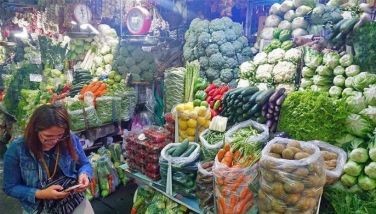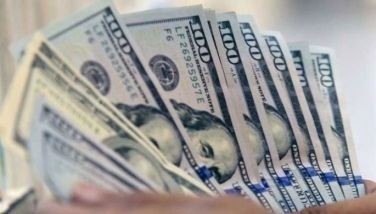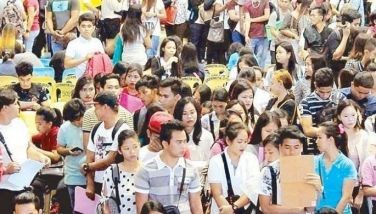On traffic, shipping, and Imao’s artwork

The peak of the “ber†Christmas holiday months barely around the corner, without any substantial action being introduced to alleviate current traffic conditions, it’s only reasonable to expect further clogging of Metro Manila’s main roads.
In past columns, there had been extensive discussions with the participation of many readers on how to improve the flow of traffic within the metropolis. We have another reader who sent in some suggestions, which hopefully will reach the ears of those concerned in government.
Here are a few words from Dawn Santos: “I am one of those who are sick of traffic in Manila. MMDA Chairman Tolentino has tried to ease the chaotic traffic conditions but [it’s just] media hype and not … implementing the rules he has crafted like:
“1) Painted the yellow lane for buses/public vehicles. Everybody knows that buses and jeepneys do not stay within these yellow lanes. It was just a waste of money (to have) these yellow lanes.
“2) Designated and wasted motorcycle lanes. These motorcycles do not stay or use these lanes.
“3) MMDA personnel were assigned to monitor the traffic conditions and guide/implement traffic rules. Observation? These MMDA traffic enforcers grouped themselves in four to five or even more and just stay in one place where sometimes no traffic is observed, and yet in places where they are needed, they are not there! Is it a rule that they should group themselves in fours or fives or sixes, instead of assigning themselves to several places in ones or twos where there is traffic?
“Sometimes they hide themselves behind trees and then suddenly appear when someone breaks the traffic rule for their ‘kotong’.
“A suggestion (and I hope it will be considered): Public transport stops should not be in the intersections. They block traffic more. Public stops should be 500 meters away from intersections. This will not solve the traffic problem, but will at least help to ease traffic problems.â€
A plea from tramping sector
Our last letter sender sent additional comments about the country’s domestic shipping industry, himself personally involved in Avega Bros. Integrated Shipping Corp., which is a member of the United Trampers Association of the Phils. Following is Alec N. Vega’s letter:
“Thank you for your Philippine STAR article of Sept. 10, 2013. I commend your good grasp and understanding of the problems besetting the Philippine shipping industry particularly the domestic coast-wise cargo tramping (bulk & break-bulk) sector in which we belong.
“We have been in this industry since 1981 and from my recollection, port development and improvement has been at a snail’s pace as compared to the quadrupling (if not more) of tramping cargo vessels, not to mention other types of vessels, plying our coast-wise trade because of the increase in cargo volumes through the years.
“Our seaports are so backward that it takes several days or a week for a vessel to load and the same amount of time to unload a 2,000-metric ton cargo from major city ports due to so many factors which other advance countries can do in a day or two.
“Because of these longer lay-times, our ports become so congested that it is very common a vessel will have to wait at anchorage, sometimes taking up to a week before it could get an available berth. In this situation, a 2,000 tons cargo vessel would be lucky to make three trips is two months (1.5 trips per month).
“If only port lay-time would be lessened through efficient cargo handling methods (modernization), freight rates would drastically go down. For our sector, our port handlers doesn’t even provide for simple loading/unloading equipment that we have to refit our cargo vessels with cranes, which would actually add to our cost and payload, each time we import from Japan.
Most neglected
“In the shipping industry, the tramping sector is the most neglected sector and yet the Philippine Ports Authority and the arrastre and stevedoring firms realize a big portion of their income in this sector.
“A lot of times during port congestion and in the middle of loading/unloading our cargoes, tramping vessels are called to pull-out from berth once a domestic liner/container vessel or any foreign vessel arrives, only to return once these two types of vessels are done with their loading/unloading operation.
“We, the tramping operators have the lowest priority as port users. For us to escape this predicament, the PPA should construct more safe ports and piers to accommodate the growing shipping industry. PPA should encourage competition among cargo handlers in all ports so cargo handling would improve and modernize.
“With government’s help in addressing our Philippine ports and cargo handling efficiency can we only compete and lower our freight rates in this industry.
“Once again, thank you for your understanding on the plight of our industry.â€
Juan Sajid Imao’s ‘Abutin ang Tagumpay’ sculpture
Recently, media featured the loss by the Art Association of the Philippines of an art work displayed at the Kanlungan ng Sining at Rizal Park run and managed by the National Park Development Office.
The lost item is an artwork of award-winning sculptor Juan Sajid Imao, the son of National Artist Sculptor Abdulmari Asia Imao. Sajid is also behind bigger masterpieces such as the imposing Lapu Lapu monument at the Rizal Park in Manila and Gallery of Presidents in the walled city of Intramuros.
Another well-known Juan Sajid Imao work is the Manuel V. Pangilinan Perpetual Trophy which Champions League (PCCL) awards to the reigning National Collegiate Champion. The symbol of collegiate basketball supremacy in the country is an imposing bronze trophy inspired by the theme Abutin ang Tagumpay (Reaching for success), showing several hands reaching high for a basketball.
Almost parallel to the ideals and objectives of the PCCL, Imao too aimed higher and did not allow limitations to be in the way of turning opportunities to bigger accomplishments. Imao has deteriorating eyesight due to a retinal problem, but that did not deter him from being one of the country’s foremost and internationally acclaimed sculptors.
Being the national collegiate champion for 2012, University of Sto. Thomas (UST) was in possession of the prestigious sculpture for a year. It was recently returned to Philippine Collegiate Champions League (PCCL) for safekeeping until its awarding to the 2013 national collegiate champion.
Engraved in the MVP Perpetual Trophy are national collegiate champions for the past decade, namely: UST Growling Tigers (2012); San Sebastian College-Recoletos Golden Stags (2011); Ateneo Blue Eagles (2010, 2009 and 2007); DLSU Green Archers (2008); UE Warriors (2006 and 2003); and FEU Tamaraws (2004 and 2005).
Facebook and Twitter
We are actively using two social networking websites to reach out more often and even interact with and engage our readers, friends and colleagues in the various areas of interest that I tackle in my column. Please like us at www.facebook.com and follow us at www.twitter.com/ReyGamboa.
Should you wish to share any insights, write me at Link Edge, 25th Floor, 139 Corporate Center, Valero Street, Salcedo Village, 1227 Makati City. Or e-mail me at [email protected]. For a compilation of previous articles, visit www.BizlinksPhilippines.net.
- Latest
- Trending




























